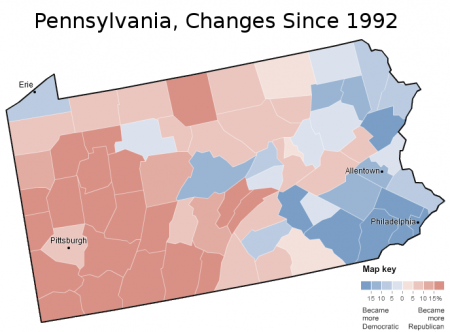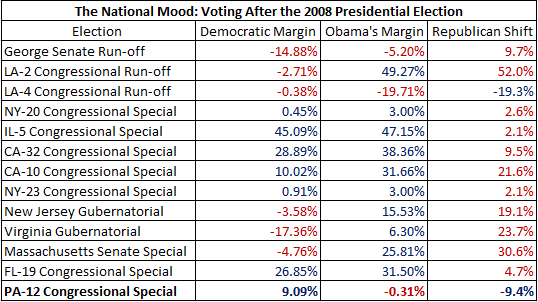Here is my first attempt at redistricting Pennsylvania. This one will be much better.
Chris Carney, Tim Holden, Jason Altmire, Kathy Dahlkemper, and Mark Critz are all Democratic Congressmen representing districts that Obama lost. I’m going to fix that. This plan creates 14 Congressional districts (out of 18) where the Democrats are favored to win. It preserves communities of interest. It looks much cleaner and less gerrymandered than the current map. And it has a VRA district that’s the most Democratic district in America.
1st District Bob Brady (D)
East Philadelphia (yellow)
New 70%O 29%M Old 88%O 12%M
63% White, 11% Black, 17% Hispanic, 7% Asian
It’s a big drop from 88% to 70% but he’s still safe.
2nd District Chaka Fattah (D)
West Philadelphia (dark blue)
New 96%O 4%M Old 90%O 10%M
13% White, 75% Black, 6% Hispanic, 4% Asian
Compare the demographics of districts 1 and 2, and then notice that what separates them is mostly a single straight line. That’s how segregated Philadelphia is. This is the most Democratic district in the country. Since Pennsylvania has enough votes to spare, it should compete for that honor.
3rd District Brian Lentz (D)
Delaware County, southern Chester County (brown)
New 58%O 41%M Old 56%O 43%M
75% White, 16% Black, 4% Hispanic, 4% Asian
It gets all of Delaware County, including the black parts currently in PA-1. This makes it 2 points more Democratic.
4th District Allyson Schwartz (D)
Montgomery County (green)
New 62%O 37%M Old 59%O 41%M
80% White, 9% Black, 3% Hispanic, 6% Asian
Most of Montgomery County is now one solid compact district, and it’s safe Dem.
5th District Patrick Murphy (D)
Bucks County (orange)
New 54%O 45%M Old 54%O 45%M
88% White, 4% Black, 3% Hispanic, 4% Asian
It’s a tiny bit more Democratic than it was before. If you keep all of Bucks County in one district then there’s not much you can do.
6th District Jim Gerlach (R) or Manan Trivedi (D)
West Chester, Coatesville, Reading (peach)
New 55%O 44%M Old 58%O 41%M
81% White, 6% Black, 10% Hispanic, 3% Asian
If Jim Gerlach gets reelected this year then this plan won’t work. If he keeps winning 52% of the vote in his district then he’ll win a safe 55% of the vote in a district that’s 3% more Republican. The only way to dislodge him will be to put some lower Montgomery County in this district and then put a lot of Berks County in Allyson Schwartz’s district. It will be ugly and un-communities-of-interest-ish and no one wants that. However if Trivedi wins this year (and I think he will) then he should be able to hold a 55% Obama district that gets more Democratic every year and is centered around his home in Berks County.
7th District Charlie Dent (R)
Allentown, Bethlehem, Easton (pale blue)
New 57%O 42%M Old 56%O 43%M
79% White, 5% Black, 12% Hispanic, 2% Asian
At 57% Obama it will have to go Democratic eventually. This counts towards one of the 14 D’s.
8th District Tim Holden (D) vs Paul Kanjorski (D)
Wilkes-Barre, Pottsville, Stroudsburg (lime green)
New 53%O 45%M Old 57%O 42%M
88% White, 4% Black, 6% Hispanic, 1% Asian
Obama won a 50% plurality in this part of Schuylkill County and he got 56% of Luzerne. It’s not the best at communities of interest. It has a liberal city (Wilkes-Barre), rich liberal rural area (Monroe Co), poor rural barely-Democratic areas (Carbon, Schuylkill, rest of Luzerne Co) and conservative suburbs (Northampton and Lehigh Co). If Kanjorski beats Barletta this year then it’s worth taking our chances on a 53% Obama district, especially with Monroe County which is quickly getting more populous and more Democratic. If Barletta wins then a 14-4 plan goes out the window, and instead Barletta gets a more Republican version of this district, and Carney gets a safe Scranton and Wilkes-Barre district.
9th District Chris Carney (D)
Scranton, State College, Northern Tier (pink)
New 52%O 46%M Old 45%O 54%M
93% White, 2% Black, 3% Hispanic, 2% Asian
Carney gets a 52% Obama district. I’m sure he’ll appreciate that as he drives 300 miles to a townhall in Warren. It has 2 different centers of population, Scranton and State College, but so what, lots of congressional districts have 2 different centers of population (right?). Carney is the second biggest winner from this plan.
10th District Glenn Thompson (R)
Williamsport, Bloomsburg, Lebanon (cyan)
New 41%O 58%M Old 44%O 55%M
93% White, 3% Black, 3% Hispanic, 1% Asian
This is the first of 4 Republican districts. It’s the only one with any chance of going Democratic within the decade. Maybe it’s 10 years behind NY-20 (a comparable rural northern district) and will trend Democratic.
11th District Todd Platts (R)
Lancaster County, York County, Adams County (blue-purple)
New 37%O 62%M Old 43%O 56%M
94% White, 2% Black, 2% Hispanic, 1% Asian
This district is as Republican as the current PA-19 was 10 years ago. This is the smallest (densest) Republican district. It is trending Democratic, but not fast enough for a Democrat to win it within the next decade.
12th District open
Lancaster, York, Harrisburg (gray)
New 54%O 45%M
76% White, 11% Black, 9% Hispanic, 2% Asian
Obama won each of the 3 county fragments and narrowly lost the Cumberland part. Since we can make a Democratic district out of the 3 mid-state cities and their suburbs, we should.
13th District Bill Shuster (R)
Chambersburg, Bedford, Altoona (turquoise)
New 34%O 64%M Old 35%O 63%M
95% White, 2% Black, 1% Hispanic, 1% Asian
Definitely the most Republican district in the Northeast, maybe one of the 20 most Republican districts in the country. And it no longer reaches west to suck up Democratic votes in Fayette and Indiana counties.
14th District Mark Critz (D)
Washington, Uniontown, Johnstown (red)
New 50%O 49%M Old 49%O 50%M
93% White, 4% Black, 1% Hispanic, 1% Asian
It’s a thicker, less gerrymandered-looking version of the Critz district. It has the least % Obama of all 14 Democratic districts. Obama only won a 50% plurality, but as you know, this area is more Democratic at the local level than the presidential level. Obama won the Beaver, Washington, Indiana, and Clearfield parts of this district. Out of the 14, I think this is the district that is most likely to go Republican within the next decade.
15th District Mike Doyle (D)
Pittsburgh, Braddock, McKeesport (purple)
New 56%O 44%M Old 70%O 29%M
86% White, 8% Black, 2% Hispanic, 1% Asian
In order to protect 4 incumbents in Western PA Mike Doyle had to take one for the team. Pittsburgh gets spread between 2 districts. Still, at 56% Obama, and stronger at the local level, it shouldn’t be a problem for Doyle or any Democrat who succeeds him.
16th District Jason Altmire (D)
Pittsburgh, Ross, Lower Burrell (green)
New 55%O 44%M Old 44%O 55%M
80% White, 15% Black, 1% Hispanic, 2% Asian
By losing Butler County and gaining half of Pittsburgh, Altmire is the biggest winner from this redistricting plan. Hopefully Altmire is adaptable, and this district will allow him (or force him) to vote more liberally.
17th District Tim Murphy (R)
Greensburg, Butler, Punxsutawney (yellow)
New 38%O 61%M Old 44%O 55%M
97% White, 1% Black, 1% Hispanic, 1% Asian
It doesn’t look like Tim Murphy’s old district, but 23% of it overlaps with his old district. After putting anything remotely Democratic in a Democratic district, this is what you have leftover.
18th District Kathy Dahlkemper (D)
Erie, Hermitage, New Castle (blue)
New 52%O 47%M Old 49%O 49%M
91% White, 5% Black, 2% Hispanic, 1% Asian
This is about the most Democratic possible compact northwestern district. As Mercer, Lawrence and Beaver trend Republican, Erie is trending more Democratic, so that should help the district stay Democratic.






